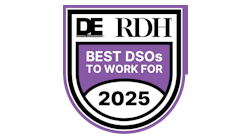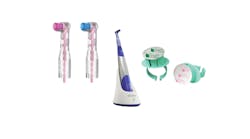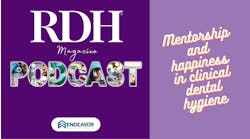In this series, we’ve talked about the overall results of our survey (in the August issue) and then, specifically, why sharpening is important to the business health of a practice (in the September issue). So you may find yourself saying, “OK, I’m ready to start a new sharpening routine—but I’m not sure of my technique. How do I actually get better at this?” If you’re ready to put the curette to the sharpening stone, read on!
If you feel less than confident in your sharpening skills, you’re not alone. Only 34% of the respondents to our survey said they felt “very confident” in their skills, meaning that the other two-thirds were somewhere either “somewhat confident,” “neither confident nor unconfident,” “somewhat unconfident,” or “very unconfident” (the numbers were 38%, 12%, 11%, and 5%, respectively). One respondent who indicated that she was early on in her career said that she was “intimidated” by the thought of ruining her instruments and “frustrated” by the amount of time it could take. Others reported just generally feeling unsure, although the most prominent issue was a lack of time or an employer who did not value the sharpening of instruments.
Sharpening instruction in school
To better understand these results, I reached out to the members of our editorial advisory board to ask them about their experience learning how to sharpen instruments in school. They all agreed that usually, lessons on sharpening were limited, although this wasn’t a universal experience.
Staci Violante, RDH, now an instructor at NYU herself, said that “My experience in school was one short lesson and a competency test on it—that was all. The instruction was sufficient.” Kristin Goodfellow, RDH, reported that “Our instructors demonstrated the process in class on both a stone and a mechanical sharpener for maybe an hour. But I had never sharpened an instrument until I got in a private practice. This was at no fault to our instructors, there was so much information condensed into a semester that sharpening was not something we spent a lot of time on, unfortunately.” Amber Auger, MPH, RDH, had a similar experience, saying that “My experience with sharpening was very limited. I was taught different ways by different instructors. I knew how to get them sharp, but not always how to preserve the working end in the beginning of my clinical career.”
Amber Metro-Sanchez, BA, RDH, shared that her instructors took a somewhat different approach: “My dental hygiene instructors taught me that instrument sharpening was an important component of our profession. Any time that we did not have patients during clinic, we were encouraged to sharpen our instruments. I felt quite confident in my skills at the time and the instructors were always available if I had any questions.”
Given time limitations and inconsistencies between programs, it’s understandable that many students leave hygiene school not feeling confident in their ability to sharpen. Our editorial advisory board said that formal hands-on opportunities to learn to sharpen (such as continuing education) after graduation can be hard to come by. So what’s a hygienist who wants to learn to do?
Finding learning resources
If you think your technique could use some work, or you’d just like a refresher, you have a few options. One is, of course, asking a colleague. Kristin Goodfellow said that when she graduated, “I had no technique, so it has really evolved. I learned out of necessity—it was learn or work with dull instruments. I was lucky that the other hygienist in my practice took the time to really teach me how to do it properly.” But other members of the board said that they’d never been asked by a colleague about sharpening.
A favorite resource among our advisory board was online videos. “I love to check out YouTube videos for a quick refresher on instrument sharpening,” said Metro-Sanchez. “Hu-Friedy has quite a few of them on YouTube covering that subject. I recently viewed “How to Sharpen Gracey Curettes” to make sure I was getting the angles right.” Goodfellow also said that “Because I still live in fear of ruining my instruments, I always refer to the Hu-Friedy videos to make sure I am doing things correctly. It is so easy to distort the shape and cutting edge of your instrument that I would rather be safe than sorry!”
You could also take advantage of local in-person continuing education at local events or at larger national ones, such as RDH Under One Roof. Auger shared that “I love webinars, podcasts, dental conference CE, and study clubs. I am proud to be a forever student, as I am consistently learning new techniques to empower my patients.”
If you choose to sharpen instruments on your own, there are quite a few tool options available, which means that hygienists can ideally find something that works well for them. In a June 2018 RDH magazine article, Pat Pine, RDH, COM describe what’s out there: there’s everything from motorized automatic options to a traditional stone. “The types of DIY sharpening tools are still broken down into three categories: acrylic test stick, flat stones, or a specific sharpening bur with a high-speed handpiece,” she writes. “The flat stones are typically a white stone or a red stone. Some guides such as the Gleason Guide (PDT) offer quick assistance to practitioners who are sharpening off a stone.” Fully automatic mechanical options offer hygienists a way to not have to worry about manual technique at all while still having access to sharp instruments on demand.
Other ways to sharpen instruments
Some practices have an assigned sharpener, such as Auger’s: “I am the ‘office sharpener’ in charge of helping others with instruments and often being bribed to sharpen their cassettes. I find it fun to do, now that I am confident in how I sharpen.”
If you don’t have a colleague who will sharpen instruments for you, your practice could take advantage of sharpening services, in which dull instruments are mailed off, such as those offered by Nordent and Hu-Friedy.
“The key to efficient, accurate sharpening is consistency,” says Tim Irwin, a vice president at Nordent Instruments. “For most, sharpening the small blades of scalers and curettes is not an intuitive skill and the key component to sharpening accurately is to sharpen regularly. Whether you are using a sharpening device or a guide, sharpening by hand, there is a technique involved that is either refined through regular use or deteriorates with disuse.” Also, sharpening is not exactly something you can play catch-up with, he warned: “Additionally, the longer an instrument goes without being sharpened, the rounder the cutting edge becomes, making it more difficult to restore the sharp edge at the correct angle. That’s why many offices depend on a professional sharpening service, either to supplement sporadic in-office sharpening or as a completely hands-off solution. At Nordent, we have some offices that sharpen in-office and send us their instruments once or twice a year to restore the original blade surfaces and angles, and we have other offices that send us their kits regularly and depend on us as a hands-off solution.”
Conclusion
Every clinical hygienist needs sharp instruments to work with, and there are many ways to arrive at that point, even if you feel your technique has waned over the years (or never really was great to begin with). From brushing up on your skills at a CE course or using a YouTube video, to buying a sharpening machine, to simply passing on the task of sharpening to someone else, what matters is not how your instruments got sharp, but simply that they do! In our next installment of this series, we’ll be hearing from experts about why sharp instruments are so important to the overall health of a patient.
Reference
1. Pine P. DIY, or get the service? RDH magazine website. https://www.rdhmag.com/articles/print/volume-38/issue-6/content/diy-or-get-the-service.html. Published June 1, 2018. Accessed September 26, 2018.





